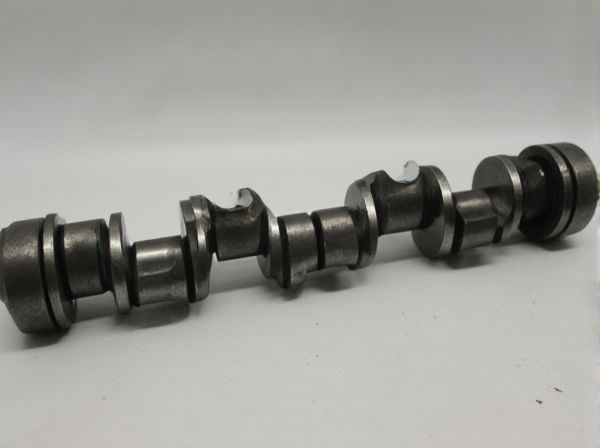
Photo illustration: Stroke Crankshaft vs Destroked Crankshaft
A stroke crankshaft increases an engine's displacement by lengthening the piston travel, resulting in higher torque and power output, ideal for performance enhancement. A destroked crankshaft reduces the stroke length, lowering displacement to achieve higher engine rev limits and improved responsiveness, often favored in racing applications. Understanding the difference helps you choose the right setup for balancing power and engine speed based on your driving or performance goals.
Table of Comparison
| Feature | Stroke Crankshaft | Destroked Crankshaft |
|---|---|---|
| Definition | Crankshaft with longer piston stroke length | Crankshaft with reduced piston stroke length |
| Displacement | Increases engine displacement | Decreases engine displacement |
| Torque | Higher low-end torque | Lower torque, optimized for high RPM |
| RPM Range | Lower redline, better mid-range power | Higher redline, better top-end power |
| Fuel Efficiency | Less fuel-efficient due to larger displacement | More fuel-efficient with smaller displacement |
| Engine Stress | Increased piston speed, higher mechanical stress | Reduced piston speed, lower mechanical stress |
| Use Case | Best for torque-focused applications like towing | Best for high-performance racing and speed |
Understanding Crankshaft Terminology
A stroke crankshaft refers to the total distance the piston travels up and down within the cylinder, directly impacting engine displacement and power output. Destroked crankshafts reduce this piston travel distance to decrease engine displacement, often improving high-RPM engine performance and reducing internal stress. Understanding these terms is essential for optimizing engine tuning and achieving desired performance characteristics in both racing and street applications.
What is a Stroked Crankshaft?
A stroked crankshaft increases engine displacement by extending the piston's travel distance within the cylinder, which enhances torque and overall power output. This modification improves low-end performance and acceleration by allowing greater air and fuel mixture intake during the combustion cycle. Stroked crankshafts are commonly used in performance tuning to boost engine efficiency and responsiveness compared to standard, or destroked, crankshafts that reduce piston travel for higher RPM potential.
What is a Destroked Crankshaft?
A destroked crankshaft reduces the engine's stroke length, resulting in a smaller displacement and higher RPM capability compared to a stroked crankshaft that increases stroke length for more torque. By shortening the crankshaft throw, a destroked engine experiences less piston travel, which decreases internal stresses and improves engine reliability at high speeds. This modification is popular in racing applications where high-revving engine characteristics and quick throttle response are critical for performance.
Key Differences Between Stroked and Destroked Crankshafts
Stroked crankshafts increase engine displacement by lengthening the piston stroke, resulting in higher torque and power output at lower RPMs, making them ideal for performance applications requiring strong low-end power. Destroked crankshafts reduce the piston stroke, enabling higher RPM capabilities and quicker engine response, favoring high-revving performance and improved acceleration. Key differences include changes in engine bore-to-stroke ratio, combustion characteristics, and overall engine durability due to altered piston speed and stress profiles.
Performance Impact: Stroke vs Destroke
A stroked crankshaft increases engine displacement by lengthening the piston travel, resulting in higher torque and improved low-end power, which enhances overall performance in acceleration and towing. In contrast, a destroked crankshaft shortens the piston travel, reducing displacement, which typically increases engine RPM capabilities and horsepower at high revs but lowers torque output. Choosing between stroked and destroked crankshafts depends on performance goals, with stroked setups favoring torque and drivability, while destroked configurations aim for higher revving horsepower.
Engine Reliability and Longevity
Stroke crankshafts increase engine displacement by lengthening the piston travel, which can result in higher power output but may place additional stress on engine components, potentially reducing reliability and longevity if not properly engineered. Destroked crankshafts reduce piston travel, lowering displacement and engine stress, which often enhances durability and extends engine life by minimizing mechanical strain and heat generation. Engine reliability and longevity depend on factors like material quality, design precision, and maintenance, but generally, destroked crankshafts favor longer engine life through reduced internal stress.
Common Applications for Stroked Crankshafts
Stroked crankshafts increase engine displacement by lengthening the piston stroke, commonly used in high-performance vehicles, muscle cars, and racing engines to boost torque and horsepower. These crankshafts are favored in applications where enhanced low-end power and acceleration are critical, such as drag racing and off-road vehicles. In contrast, destroked crankshafts reduce stroke length to improve engine revving capabilities, usually applied in high-revving sports cars and motorcycle engines prioritizing top-end power.
Benefits of Destroked Crankshafts
Destroked crankshafts reduce the engine's stroke length, leading to lower piston speeds and decreased internal stress, which enhances engine reliability and durability. This modification allows higher engine RPM, improving power output and acceleration without significantly increasing engine displacement. Additionally, destroked crankshafts contribute to improved fuel efficiency and reduced emissions by optimizing combustion dynamics.
Choosing the Right Crankshaft for Your Build
Choosing the right crankshaft for your build depends on your performance goals and engine configuration. A stroke crankshaft increases displacement and torque by lengthening the piston travel, ideal for applications requiring low-end power and torque gains. Conversely, a destroked crankshaft reduces displacement to achieve higher RPMs and quicker engine response, suitable for high-revving setups focused on peak horsepower.
Conclusion: Stroke or Destroke—Which is Better?
Choosing between a stroke crankshaft and a destroked crankshaft depends on performance goals; a stroked crankshaft increases engine displacement and torque, enhancing low-end power and acceleration, while a destroked crankshaft reduces displacement, allowing higher RPMs and improved top-end horsepower. For applications prioritizing durability and fuel efficiency, a destroked crankshaft offers smoother operation and reduced internal stress. Performance enthusiasts seeking maximum torque and a robust powerband often benefit more from a stroked crankshaft setup.
 caratoz.com
caratoz.com